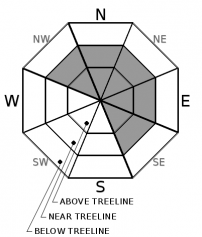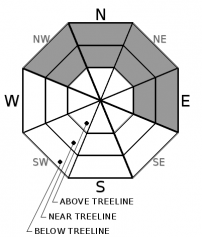| Tuesday | Tuesday Night | Wednesday | |
|---|---|---|---|
| Weather: | Mostly cloudy. Chance of snow. Snow levels below 7000 feet. Chance of precipitation is 55%. | Cloudy. Chance of snow in the evening, then slight chance of snow showers after midnight. Snow levels below 7000 feet. Chance of precipitation is 50%. | Mostly cloudy. Snow levels below 7000 feet. Chance of precipitation is 10%. |
| Temperatures: | 34 to 39. deg. F. | 23 to 28. deg. F. | 37 to 42. deg. F. |
| Mid Slope Winds: | Southwest 15 to 25 mph with gusts to 45 mph. | Southwest 15 to 25 mph with gusts to 45 mph decreasing to 15 to 20 mph with gusts to 35 mph after midnight. | Southwest around 15 mph with gusts to 25 mph in the morning becoming light. |
| Expected snowfall: | 80% probability of 1 to 3 inches. 20% probability of 3 to 5 inches. | SWE = up to 0.15 inch. | 80% probability up to 1 inch. 20% probability of 1 to 3 inches. | SWE = less than 0.15 inch. | No accumulation. | SWE = none. |
| Tuesday | Tuesday Night | Wednesday | |
|---|---|---|---|
| Weather: | Mostly cloudy. Chance of snow. Snow levels below 7000 feet. Chance of precipitation is 50%. | Mostly cloudy. Chance of snow in the evening, then slight chance of snow showers after midnight. Snow levels below 7000 feet. Chance of precipitation is 55%. | Mostly cloudy. Snow levels below 7000 feet. Chance of precipitation is 10%. |
| Temperatures: | 28 to 34. deg. F. | 20 to 25. deg. F. | 33 to 39. deg. F. |
| Ridge Top Winds: | Southwest 30 to 45 mph with gusts to 85 mph. | Southwest 30 to 45 mph with gusts to 90 mph decreasing to 20 to 35 mph with gusts to 60 mph after midnight. | Southwest 20 to 30 mph with gusts to 50 mph decreasing to 15 to 20 mph with gusts to 35 mph in the afternoon. |
| Expected snowfall: | 80% probability of 1 to 3 inches. 20% probability of 3 to 5 inches. | SWE = up to 0.15 inch. | 80% probability up to 2 inches. 20% probability of 1 to 3 inches. | SWE = less than 0.15 inch. | No accumulation. | SWE = none. |


























